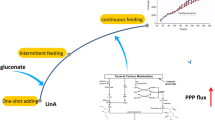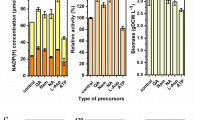Abstract
The effects of eight cofactors of enzymes on daptomycin production were investigated in this work, which included nicotinic acid (VPP), riboflavin (VB2), heme, thiamine (VB1), biotin (VH), cyanocobalamin (VB12), tetrahydrofolic acid (THF) and pyridoxal 5-phosphate (VB6). The dry cell weight (DCW), consumption of glucose, and daptomycin production were obviously improved when proper amount of exogenous cofactors were supplemented in the medium. The effects of heme, THF, VB12 and VB6 on daptomycin production were especially notable. The daptomycin yield enhanced 363, 104, 53 and 46%, respectively, when optimized amount of these four cofactors were supplemented in the broth. Moreover, the daptomycin yield further increased to 632 mg/l, which was over 4.5-fold higher than that of the control (without cofactors), at 132 h in a 7.5-l fermenter, by supplementation all of the eight cofactors at optimized concentrations (VPP 4 mg/l, VB2 0.5 mg/l, heme 9 mg/l, VB1 0.4 mg/l, VH 0.1 mg/l, VB12 0.04 mg/l, THF 6 mg/l and VB6 0.4 mg/l). Further, the effects of cofactors on the corresponding key enzymes and important intracellular metabolites were studied in order to elucidate the mechanism of enhancement of daptomycin production by manipulation of cofactors concentration in the fermentation culture. It is suggested that this strategy for increasing the daptomycin production in Streptomyces roseosporus LC-51 by manipulation of cofactors concentration in the fermentation culture may provide an alternative approach to enhance the production of metabolites in other Streptomyces.







Similar content being viewed by others
References
Baltz RH, Miao V, Wrigley SK (2005) Natural products to drugs: daptomycin and related lipopeptide antibiotics. Nat Prod Rep 22:717–741
Fitzgerald DH, Muirhead KM, Botting NP (2001) A comparative study on the inhibition of human and bacteria kynureninase by novel bicyclic kynurenine analogues. Bioorg Med Chem 9:983–989
Garrasa A, Djurhuus R, Christensena B, Lillehaugb JR, Uelanda PM (1991) A nonradioactive assay for N5-methyltetrahydrofolate-homocysteine methyltransferase (methionine synthase) based on o-phthaldialdehyde derivatization of methionine and fluorescence detection. Anal Biochem 199:112–118
He JY, Deng JJ, Zheng YH, Gu J (2006) A synergistic effect on the production of S-adenosyl-l-methionine in Pichia pastoris by knocking in of S-adenosyl-l-methionine synthase and knocking out of cystathionine-β synthase. J Biotechnol 126:519–527
Hinman LM, Blass JP (1981) An NADH linked spectrophotometric assay of pyruvate dehydrogenase complex of crude tissue of homogenates. J Biol Chem 156:6583–6586
Ishimura YNM, Hayaishi O (1970) The oxygenated form of l-tryptophan 2, 3-dioxygenase as reaction intermediate. J Biol Chem 245:593–602
Kim PM, Aizawa H, Kim PS et al (2005) Serine racemase: activation by glutamate neurotransmission via glutamate receptor interacting protein and mediation of neuronal migration. Proc Natl Acad Sci USA 102:2105–2110
Kurnasov O, Jablonski L, Polanuyer B, Dorrestein P, Begley T, Osterman A (2003) Aerobic tryptophan degradation pathway in bacteria: novel kynurenine formamidase. FEMS Microbiol Lett 227:19–27
Li Y, Chen J, Lun SY et al (2001) Efficient pyruvate production by a multi-vatamin auxotroph of Torulopsis glabrata: key role and optimization of vitamin levels. Appl Microbiol Biotechnol 55(6):680–685
Liu LM, Li Y, Shi ZP, Du GC, Chen J (2006) Enhancement of pyruvate productivity in Torulopsis glabrata: Increase of NAD(+) availability. J Biotechnol 126:173–185
Mahlert C, Kopp F, Thirlway J, Micklefield J, Marahiel MA (2007) Stereospecific enzymatic transformation of alpha-ketoglutarate to (2S, 3R)-3-methyl glutamate during acidic lipopeptide biosynthesis. J Am Chem Soc 129:12011–12018
Miao V, Coeffet-LeGal MF, Brian P, Brost R, Penn J, Whiting A et al (2005) Daptomycin biosynthesis in Streptomyces roseosporus: cloning and analysis of the gene cluster and revision of peptide stereochemistry. Soc Gen Microbiol 151:1507–1523
Morita N, Iizuka K, Okita K et al (2004) Exposure to pressure stimulus enhances succinate dehydrogenase activity in L6 myoblasts. Am J Physiol Endocrinol Metab 287:E1064–E1069
Nguyen KT, Kau D, Gu JQ, Brian P, Wrigley SK, Baltz RH et al (2006) A glutamic acid 3-methyltransferase encoded by an accessory gene locus important for daptomycin biosynthesis in Streptomyces roseosporus. Mol Microbiol 61:1294–1307
Payne J, Morris JG (1969) Pyruvate carboxylase in Rhodopseudomonas spheroids. J Gen Microbiol 59:97–101
San KY, Bennett GN, Berríos-Rivera SJ, Vadali RV, Yang YT, Horton E, Rudolph FB, Sariyar B, Blackwood K (2002) Metabolic engineering through cofactor manipulation and its effects on metabolic flux redistribution in Escherichia coli. Metab Eng 4:182–192
Walsh HA, Daya S, Whiteley CG (1994) Mode of inhibition of rat liver tryptophan 2, 3-dioxygenase by melatonin. J Pineal Res 16:188–192
Zempleni J, Rucker RB (2007) Handbook of vitamins. CRC Press, USA
Zhou PF, Wang YW, Guo M, Wang HH, Xie JP (2009) Daptomycin: putative new mechanisms of action and resistance evolved from transcriptome data mining. Rev Med Microbiol 20:12–18
Zhu CH, Lu FP, He YN, Han ZL, Du LX (2007) Regulation of avilamycin biosynthesis in Streptomyces viridochromogenes: effects of glucose, ammonium ion, and inorganic phosphate. Appl Microbiol Biotechnol 73:1031–1038
Acknowledgments
The authors wish to acknowledge the financial support provided by the National High Technology Research, Development Program of China (2007AA02Z200), the National Natural Science Foundation of China (No. 21076022, No. 20906070).
Author information
Authors and Affiliations
Corresponding author
Rights and permissions
About this article
Cite this article
Yu, G., Jia, X., Wen, J. et al. Enhancement of daptomycin production in Streptomyces roseosporus LC-51 by manipulation of cofactors concentration in the fermentation culture. World J Microbiol Biotechnol 27, 1859–1868 (2011). https://doi.org/10.1007/s11274-010-0644-8
Received:
Accepted:
Published:
Issue Date:
DOI: https://doi.org/10.1007/s11274-010-0644-8




